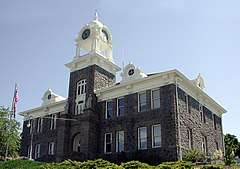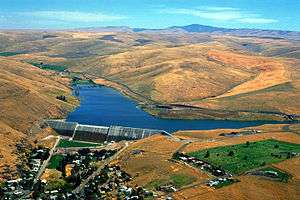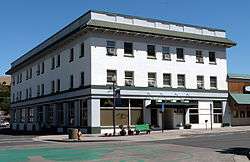Heppner, Oregon
Heppner is an incorporated city and the county seat of Morrow County, Oregon, United States. As of 2010, the population was 1,291.[5] Heppner is part of the Pendleton-Hermiston Micropolitan Area. Heppner is named after Henry Heppner, a prominent Jewish-American businessman.
Heppner, Oregon | |
|---|---|
_(morD0092).jpg) The Agricultural Collection Building of the Morrow County Museum in Heppner | |
 Seal | |
| Nickname(s): Gateway to the Blues | |
 Location in Oregon | |
| Coordinates: 45°21′22″N 119°33′10″W | |
| Country | United States |
| State | Oregon |
| County | Morrow |
| Incorporated | 1887 |
| Government | |
| • Mayor | Jim Kindle |
| Area | |
| • Total | 1.24 sq mi (3.20 km2) |
| • Land | 1.23 sq mi (3.19 km2) |
| • Water | 0.01 sq mi (0.02 km2) |
| Elevation | 2,192 ft (668 m) |
| Population | |
| • Total | 1,291 |
| • Estimate (2019)[3] | 1,266 |
| • Density | 1,029.27/sq mi (397.46/km2) |
| Time zone | UTC−8 (Pacific) |
| • Summer (DST) | UTC−7 (Pacific) |
| ZIP code | 97836 |
| Area code(s) | 458 and 541 |
| FIPS code | 41-33550[2] |
| GNIS feature ID | 1121763[4] |
| Website | www.cityofheppner.com |
History
Native American settlement
Native Americans lived and traveled along the land between the Columbia Gorge and the Blue Mountains for more than 10,000 years prior to European-American settlement. Ancient petroglyphs have been found approximately 45 miles (72 km.) north of Heppner in Irrigon and Boardman.[6] In 1855, the U.S. Government and the predominant tribes in the region—the Cayuse, Umatilla, and Walla Walla—signed a treaty whereby the tribes gave up, or ceded, to the United States more than 6.4 million acres in what is now northeastern Oregon and southeastern Washington.[7]
European-American settlement
Prior to Heppner's founding in 1872, European-American ranchers used the area as sheep and cattle range as early as 1858. Records suggest these early cattlemen found abundant rye grass along creek bottoms.[8]
Heppner was originally called Standsbury Flats for George W. Standsbury, one of the first European-American settlers in the area.[9][10][11] In 1872, Colonel (Col.) Jackson Lee Morrow, a merchant, entered into a partnership with Henry Heppner, a prominent Jewish businessman,[12] and they built a store on the crossing of the present May and Main streets.[11][8][9] Soon thereafter, a mail and stagecoach line began operations between Pendleton and The Dalles and passed through Heppner.[13]
Col. Jackson Lee Morrow was later elected to the Oregon legislative assembly and was instrumental in helping to carve out a new county for Heppner from neighboring Umatilla County and a portion of Wasco County.[14] The assembly named the new county in Morrow's honor.[13]
Heppner was designated the temporary county seat at the time the county was created and narrowly defeated nearby Lexington in an election held in 1886 to determine the permanent county seat.[9][15] Heppner was incorporated in the following year on February 9, 1887.[16][11]
In 1888, the Oregon Railroad and Navigation Company completed a railroad spur from the Columbia River up the Willow Creek drainage to Heppner.[13]
The Historic Morrow County Courthouse was built in 1902-03 and is one of the oldest continuously used courthouses in Oregon.[17] In 1985, the courthouse was listed on the National Register of Historic Places.[18]

Flood of June 1903
Heppner was almost destroyed by a flash flood on Sunday, June 14, 1903.[19] The flood was precipitated by a sudden cloudburst and accompanying hail that caused a debris dam collapse and flash flooding, notably on Willow Creek.[19] A wall of water and debris swept down the creeks and canyons and through the city. It has been estimated that 238 people (a quarter of the city's population) drowned, making it the deadliest natural disaster in Oregon's history.[19] Property damage was reported at nearly $1 million. The nearby cities of Ione and Lexington also sustained significant damage.[19] In 1983, the Willow Creek Dam at the outskirts of the city was finished.[19]

Post-flood recovery
The railroad and a growing network of roads had by the early decades of the 20th century made Heppner a trade center and distribution point for regional farm products including wheat, alfalfa, sheep, cattle, horses, and hogs. Despite the flood and two fires in 1918 that destroyed City Hall, the Palace Hotel, the library, many businesses, and more than 30 homes, the community rebuilt. One of its creations, the Heppner Hotel, opened in 1920 and, housing a variety of businesses over the years, it served as a community gathering place through 1972, when its last restaurant closed.[13]

Demographics
| Historical population | |||
|---|---|---|---|
| Census | Pop. | %± | |
| 1880 | 318 | — | |
| 1890 | 675 | 112.3% | |
| 1900 | 1,146 | 69.8% | |
| 1910 | 880 | −23.2% | |
| 1920 | 1,324 | 50.5% | |
| 1930 | 1,190 | −10.1% | |
| 1940 | 1,140 | −4.2% | |
| 1950 | 1,648 | 44.6% | |
| 1960 | 1,661 | 0.8% | |
| 1970 | 1,429 | −14.0% | |
| 1980 | 1,498 | 4.8% | |
| 1990 | 1,412 | −5.7% | |
| 2000 | 1,395 | −1.2% | |
| 2010 | 1,291 | −7.5% | |
| Est. 2019 | 1,266 | [3] | −1.9% |
| source:[2][20] | |||
Census estimates
As of July 1, 2016, the annual estimate of the resident population of Heppner was 1,297.[21]
2010 Census
As of the census of 2010, there were 1,291 people, 559 households, and 370 families residing in the city. The population density was 1,049.6 inhabitants per square mile (405.3/km2). There were 647 housing units at an average density of 526.0 per square mile (203.1/km2). The racial makeup of the city was 92.5% White, 0.2% African American, 1.2% Native American, 0.3% Asian, 2.6% from other races, and 3.3% from two or more races. Hispanic or Latino of any race were 3.7% of the population.[2]
There were 559 households, of which 26.1% had children under the age of 18 living with them, 53.3% were married couples living together, 8.2% had a female householder with no husband present, 4.7% had a male householder with no wife present, and 33.8% were non-families. 29.3% of all households were made up of individuals, and 14.5% had someone living alone who was 65 years of age or older. The average household size was 2.30 and the average family size was 2.78.[2]
The median age in the city was 45.9 years. 22.5% of residents were under the age of 18; 6.5% were between the ages of 18 and 24; 19.6% were from 25 to 44; 29.8% were from 45 to 64; and 21.5% were 65 years of age or older. The gender makeup of the city was 50.6% male and 49.4% female.[2]
2000 Census
As of the census of 2000, there were 1,395 people, 583 households, and 398 families residing in the city. The population density was 1,138.5 people per square mile (437.9/km2). There were 660 housing units at an average density of 538.7 per square mile (207.2/km2). The racial makeup of the city was 96.70% White, 1.00% Native American, 0.43% Asian, 1.51% from other races, and 0.36% from two or more races. Hispanic or Latino of any race were 1.58% of the population.[2]
There were 583 households, out of which 28.8% had children under the age of 18 living with them, 56.6% were married couples living together, 7.5% had a female householder with no husband present, and 31.7% were non-families. 28.1% of all households were made up of individuals, and 14.8% had someone living alone who was 65 years of age or older. The average household size was 2.36 and the average family size was 2.88.[2]
In the city, the population was spread out, with 24.5% under the age of 18, 5.9% from 18 to 24, 24.3% from 25 to 44, 24.9% from 45 to 64, and 20.3% who were 65 years of age or older. The median age was 42 years. For every 100 females, there were 100.7 males. For every 100 females age 18 and over, there were 92.9 males.[2]
The median income for a household in the city was $33,421, and the median income for a family was $42,500. Males had a median income of $37,381 versus $20,714 for females. The per capita income for the city was $16,729. About 11.1% of families and 13.9% of the population were below the poverty line, including 18.9% of those under age 18 and 7.0% of those age 65 or over.[2]
Geography
Heppner is at an elevation of 2,192 feet (668 m)[4] between the Columbia River to the north and the Blue Mountains to the southeast.[22] The city is along Oregon Route 74, about 60 miles (97 km) southwest of Pendleton and 185 miles (298 km) east of Portland.[22][23]
Route 74 forms part of the Blue Mountain Scenic Byway, a 130-mile (210 km) set of roads connecting Interstate 84 (I-84) along the Columbia River with the North Fork John Day River in the Blue Mountains. Part of the route follows the Willow Creek drainage through Heppner.[24]
Heppner is upstream of Lexington, Ione, and Arlington.[22] According to the United States Census Bureau, the city has a total area of 1.24 square miles (3.21 km2), of which, 1.23 square miles (3.19 km2) is land and 0.01 square miles (0.03 km2) is water.[25]
Climate
| Climate data for Heppner, Oregon (1981–2010) | |||||||||||||
|---|---|---|---|---|---|---|---|---|---|---|---|---|---|
| Month | Jan | Feb | Mar | Apr | May | Jun | Jul | Aug | Sep | Oct | Nov | Dec | Year |
| Average high °F (°C) | 43.3 (6.3) |
47.3 (8.5) |
55.1 (12.8) |
61.3 (16.3) |
69.2 (20.7) |
76.9 (24.9) |
85.9 (29.9) |
85.7 (29.8) |
76.6 (24.8) |
64.3 (17.9) |
50.7 (10.4) |
41.2 (5.1) |
63.1 (17.3) |
| Average low °F (°C) | 27.8 (−2.3) |
29.1 (−1.6) |
33.9 (1.1) |
37.4 (3.0) |
43.7 (6.5) |
49.0 (9.4) |
53.7 (12.1) |
53.5 (11.9) |
46.9 (8.3) |
38.7 (3.7) |
32.6 (0.3) |
26.1 (−3.3) |
39.4 (4.1) |
| Average precipitation inches (mm) | 1.43 (36) |
1.11 (28) |
1.49 (38) |
1.50 (38) |
1.68 (43) |
1.36 (35) |
0.34 (8.6) |
0.37 (9.4) |
0.54 (14) |
1.13 (29) |
1.59 (40) |
1.34 (34) |
13.88 (353) |
| Average snowfall inches (cm) | 3.9 (9.9) |
2.3 (5.8) |
0.4 (1.0) |
0.1 (0.25) |
0.0 (0.0) |
0.0 (0.0) |
0.0 (0.0) |
0.0 (0.0) |
0.0 (0.0) |
0.2 (0.51) |
1.0 (2.5) |
4.2 (11) |
12.2 (31) |
| Source: NOAA[26] | |||||||||||||
Annual cultural events
Heppner hosts an annual "A Wee Bit O'Ireland" celebration around Saint Patrick's Day.[27][28] The city also hosts the annual Blue Mountain Century Bikeway, a scenic bicycle ride loop of approximately 108 miles starting and ending in Heppner.[29][30]
Economy and education
As of 2002, the five largest employers in Heppner were Morrow County, the Morrow County Health District, the Morrow County School District, the Heppner Ranger District, and the Bank of Eastern Oregon.[23]
Heppner is served by the Morrow School District, which includes Heppner Junior/Senior High School and Heppner Elementary.[31] Heppner is also served by the Heppner Branch of the Oregon Trail Library District, part of Oregon's Sage Library System.
Government
Local
Heppner is a municipal corporation with the official name City of Heppner per the 1996 Heppner Charter. The powers of the city are vested in the city council which consists of a mayor and six council members each nominated and elected from the city at large or, in case of one or more vacancies in the council, the council members whose offices are not vacant. The mayor serves two-year terms and the council members serve four-year terms. Heppner also maintains a city manager who is appointed by, and may be removed by, a majority of the entire city council. The appointment of city manager is made without regard to political considerations and solely on the basis of administrative qualifications. The mayor votes as a council member with no appointive powers.[32]
As of September 2017, Cody High serves as mayor. Council members include Teresa Hughes, John Bowles, Corey Sweeney, Dale Bates, Joanne Burleson, and Adam Doherty. Edie Ball serves as the City Manager.[33]
State
Heppner is part of Oregon State House District 57 which includes Gilliam, Morrow, Sherman, Umatilla, and Wasco counties and of Oregon State Senate District 29 which includes Gilliam, Morrow Sherman, Umatilla, Union, Wallowa, and parts of Wasco counties. As of September 2017, Representative Greg Smith (R) serves Heppner in the Oregon State House and Senator Bill Hansell (R) serves Heppner in the Oregon State Senate.[34][35]
Federal
Heppner is part of Oregon's Second Congressional District. As of September 2017, Heppner is represented by U.S. Rep. Greg Walden (R). Separately, congressional senators for Oregon include Jeff Merkley (D) and Ron Wyden (D).
Notable people
- John Francis Kilkenny, Judge, U.S. District Court for the District of Oregon and Judge, U.S. Court of Appeals for the Ninth Circuit
- Greg Smith, Oregon State Representative, District 57[34]
- Mary Van Stevens, Mayor (1955–56)
References
- "2019 U.S. Gazetteer Files". United States Census Bureau. Retrieved July 28, 2020.
- "U.S. Census website". U.S. Census Bureau. Retrieved June 20, 2013.
- "Population and Housing Unit Estimates". United States Census Bureau. May 24, 2020. Retrieved May 27, 2020.
- "Heppner". Geographic Names Information System. United States Geological Survey. November 28, 1980. Retrieved July 19, 2013.
- "2010 Census Profiles - Oregon Cities Alphabetically H‐L" (PDF). Population Research Center. Portland State University (PDX) - College of Urban and Public Affairs. August 2011.
- "Columbia River Heritage Trail". Morrow County Oregon.
- "Treaty of 1855". Confederated Tribes of the Umatilla Indian Reservation. Cayuse, Umatilla, and Walla Walla people.
- Capace, Nancy (1999). Encyclopedia of Oregon. Somerset Publishers. ISBN 0403098408.
- "Morrow County History". Oregon Secretary of State - State Archives.
- McArthur, Lewis A.; Lewis L. McArthur (2003) [1928]. Oregon Geographic Names (7th ed.). Portland, Oregon: Oregon Historical Society Press. pp. 463–64. ISBN 0-87595-277-1.
- "History of Heppner". Heppner Chamber of Commerce. Heppner Chamber of Commerce. Archived from the original on 2018-02-06.
- "Henry Heppner, Early Pioneer Jewish Businessman of Heppner, Oregon". Jewish Museum of the American West. The Western States Jewish History Association. October 7, 2015.
- Hedman, Arnie; Belsma, Ronnie; Lynch, James (April 23, 1982). "National Register of Historic Places Registration Form: Heppner Hotel" (PDF). National Park Service. Retrieved July 20, 2013.
- "Extension in Northeastern Oregon". Oregon State University Libraries - Special Collections & Archives Research Center. July 6, 2011.
- Lynch, James E.; Derickson, Patrick M. (August 17, 1984). "National Register of Historic Places Registration Form: Morrow County Courthouse" (PDF). National Park Service. Retrieved July 18, 2013.
- "Heppner Community Profile". Infrastructure Finance Authority. 2009. Archived from the original on August 13, 2014. Retrieved July 18, 2013.
- "Historic Morrow County Courthouse". Heppner Chamber. Heppner Chamber of Commerce. Archived from the original on 2017-08-30.
- "Morrow County Courthouse". National Register of Historic Places Digital Archive. National Park Service. February 28, 1985.
- Baker, Jeff (September 2, 2009). " 'Calamity' : Discovering Oregon's Deadliest Natural Disaster". The Oregonian. Retrieved September 3, 2009.
- Moffatt, Riley Moore (1996). Population History of Western U.S. Cities and Towns, 1850–1990. Lanham, Maryland: Scarecrow Press. p. 210. ISBN 978-0-8108-3033-2.
- U.S. Census Bureau. "Oregon - Annual Estimates of the Resident Population: April 1, 2010 to July 1, 2016". City and Town Population Totals Tables: 2010-2016. Archived from the original on June 2, 2017.
- The 2013 Road Atlas. Chicago, Illinois: Rand McNally. pp. 84, 85. ISBN 978-052-80062-2-7.
- "Heppner Community Profile". Oregon Infrastructure Finance Authority. 2009. Archived from the original on August 13, 2014. Retrieved July 19, 2013.
- Ostertag, Rhonda (2004). Backroads of Oregon: Your Guide to Oregon's Most Scenic Backroad Adventures. Stillwater, Minnesota: Voyageur Press. pp. 105–06. ISBN 0-89658-081-4.
- "2010 Census Gazetteer Files". United States Census Bureau. Retrieved June 20, 2013.
- "NOWData - NOAA Online Weather Data". National Oceanic and Atmospheric Administration. Retrieved May 5, 2013.
- Malgesini, Tammy (March 10, 2011). "Leprechauns Plan Wee Bit o' Fun". East Oregonian. Pendleton, Oregon. Retrieved June 20, 2013.
- "31st Annual "A Wee Bit O'Ireland"". Heppner Chamber of Commerce. Archived from the original on March 3, 2018. Retrieved July 19, 2013.
- "Blue Mountain Century Bikeway | Heppner Chamber of Commerce". www.heppnerchamber.com. Archived from the original on 2017-09-18. Retrieved 2017-09-18.
- "Oregon Parks and Recreation Department: Scenic Bikeways Blue Mountain Century Scenic Bikeway". www.oregon.gov. Retrieved 2017-09-18.
- "Our Schools". Morrow County School District. 2012. Retrieved June 28, 2012.
- "Sterling Codifiers, Inc". www.sterlingcodifiers.com. Retrieved 2017-09-18.
- "City Council & Meetings | City of Heppner". www.cityofheppner.com. Archived from the original on 2018-01-14. Retrieved 2017-09-18.
- "Representative Greg Smith". GOP - District 57 (Umatilla, Morrow, Gilliam, Sherman & Wasco Counties).
- "Senator Bill Hansell". Official Oregon Legislature Website.
Further reading
- Byrd, Joann Green (2009). Calamity: The Heppner Flood of 1903. University of Washington Press. ISBN 0295989416.
- Holbrook, Stewart (1952). "Disaster in June". The Far Corner: A Personal View of the Pacific Northwest. The Macmillan Company.
- DenOuden, Bob, 'Without a Second's Warning' The Heppner Flood of 1903. Oregon Historical Quarterly 105:1 (Spring, 2004).
- DenOuden, Bob. "Heppner Flood of 1903." The Oregon Encyclopedia, The Oregon Historical Society and Portland State University, 29 Apr. 2015.
External links
![]()
